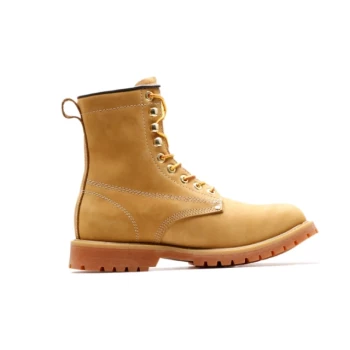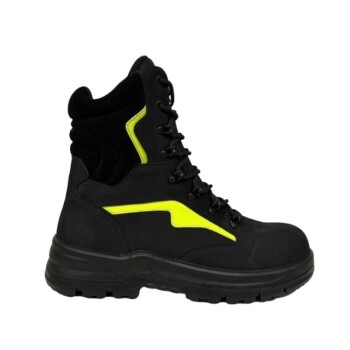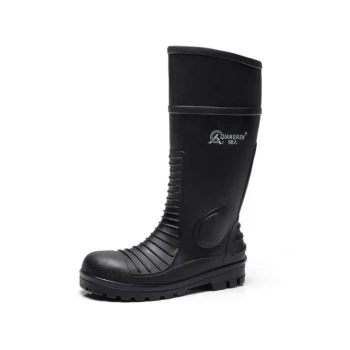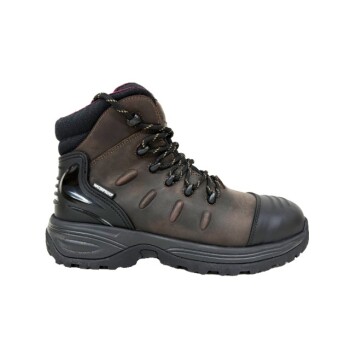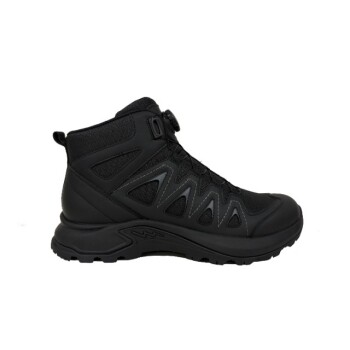At its core, the difference between a work boot and other types of cowboy boots comes down to a clear design philosophy: function over form. Work boots are engineered for safety and durability with features like reinforced toes and slip-resistant soles. Traditional cowboy boots, by contrast, are designed around the heritage of horsemanship, prioritizing features like angled heels and pointed toes for performance in the saddle.
The choice isn't merely stylistic; it's a critical decision based on your environment. Work boots are specialized safety equipment with a Western look, while traditional cowboy boots are tools designed for the specific demands of riding.
The Core Philosophy: Job Site vs. Saddle
The fundamental distinction lies in the intended purpose of the boot. Each design choice serves a specific, and often conflicting, goal.
Purpose-Built for Protection
Work boots are tools first and footwear second. Their design is dictated by the need for protection in demanding, often hazardous environments like construction sites, ranches, and industrial settings.
Rooted in Riding Tradition
Traditional cowboy boots are a direct product of their equestrian origins. Every element, from the high shaft to the heel shape, was developed to enhance a rider's safety and effectiveness on horseback.
Key Feature Breakdown: A Tale of Two Boots
Examining the specific components of each boot reveals how their distinct purposes translate into tangible design differences.
The Sole: Grip vs. Glide
A work boot's sole is built for traction. It is typically made of rubber or PVC, featuring deep lugs and a slip-resistant tread to ensure stable footing on uneven or slick surfaces. Some are also puncture-resistant.
Traditional cowboy boots often have a smoother, leather sole. This design is intentional, allowing the foot to slide easily in and out of a stirrup without catching.
The Heel: Stability vs. Security
Work boots feature a low, wide, and square heel, almost always 1.5 inches or shorter. This provides a stable, grounded platform for long hours of walking or standing.
A classic cowboy boot has a taller, angled "riding" heel, typically around 1.5 inches high. This angle is crucial for hooking onto a stirrup, preventing the rider's foot from dangerously slipping through.
The Toe Box: Reinforcement vs. Fit
The toe box on a work boot is often wider for comfort and is frequently reinforced with a steel toe or composite material for impact protection.
Conversely, traditional boots have a more pointed or rounded toe. This streamlined shape is not for fashion but for function, making it easier to guide the foot into the stirrup quickly.
Materials and Construction: Ruggedness vs. Refinement
Work boots are constructed from thick, heavy-duty leather or waterproof, chemical-resistant materials like PVC. The focus is on withstanding harsh conditions.
While still durable, traditional cowboy boots may use more polished leathers and often feature ornate stitching and decorative elements that celebrate style and cultural identity.
Understanding the Trade-offs
Using the wrong boot for the task is not just inefficient; it can be unsafe. The features that make one boot excel in its environment become liabilities in another.
The Dangers of a Work Boot in the Stirrup
The grippy, treaded sole of a work boot can easily get caught in a stirrup during a fall, posing a significant safety risk. The low, blocky heel does not offer the same level of security as a proper riding heel.
The Shortcomings of a Cowboy Boot on the Job
A traditional boot on a work site lacks critical safety features. The angled heel creates instability, the smooth sole offers poor traction, and the unreinforced toe provides no protection from falling objects or compression.
Making the Right Choice for Your Needs
To select the correct boot, you must honestly assess your primary activity. The market offers a full spectrum of options, including hybrids that blend features.
- If your primary focus is safety on an industrial job site: You need a certified Western work boot with features like a steel toe, puncture resistance, and a slip-resistant sole.
- If your primary focus is horseback riding: A traditional cowboy boot with a taller, angled heel and a smooth sole is essential for proper stirrup security.
- If your primary focus is all-day walking and general ranch work: A "roper" or "walking" style boot, with its lower square heel and wider toe, offers the best blend of comfort and stability.
- If your primary focus is Western style and tradition: Any traditional cowboy or buckaroo boot with decorative elements will meet your aesthetic needs.
Choosing the right boot means matching its engineered purpose—from the job site to the stirrup—with the real demands of your day.
Summary Table:
| Feature | Work Boots | Traditional Cowboy Boots |
|---|---|---|
| Primary Purpose | Job Site Safety & Durability | Horseback Riding & Tradition |
| Sole | Slip-resistant, lugged rubber/PVC | Smooth leather for easy stirrup entry/exit |
| Heel | Low, wide, and square (≤1.5") for stability | Taller, angled (≈1.5") for stirrup security |
| Toe | Often reinforced (steel/composite), wider | Pointed or rounded for quick stirrup access |
| Materials | Heavy-duty, rugged leather or PVC | Polished leathers, often with decorative stitching |
Need the Right Boots for Your Team or Brand?
As a large-scale manufacturer, 3515 produces a comprehensive range of footwear for distributors, brand owners, and bulk clients. Whether you need certified safety work boots for industrial job sites or authentic riding boots for the equestrian market, our production capabilities encompass all types of shoes and boots.
Let us help you equip your customers with the perfect footwear for their needs.
Contact us today to discuss your manufacturing requirements and get a quote.
Related Products
- Custom Wholesale Leather Safety Boots Direct Factory Manufacturing
- Premium Grain Leather Safety Boots for Bulk Supply
- Customizable Anti-Smash Safety Boots for Wholesale & Private Label Manufacturing
- Wholesale Slip-On Safety Boots Manufacturer - Custom Puncture-Proof & Steel Toe
- Premium High-Cut Waterproof Safety Boots Manufacturing & Wholesale Solutions
People Also Ask
- Why is manufacturer diversity and inclusion important in work boot design? For Superior Fit, Safety & Comfort
- Are safety shoes worth it? The Critical Investment in Workplace Safety & Foot Health
- Is safety-toe as good as steel toe? Choose the Right Protection for Your Job
- Is there a downside to steel toe boots? Weighing Protection Against Daily Comfort
- Why is the last important in work boot design? It's the Anatomical Blueprint for Comfort & Safety






